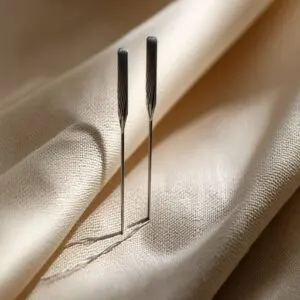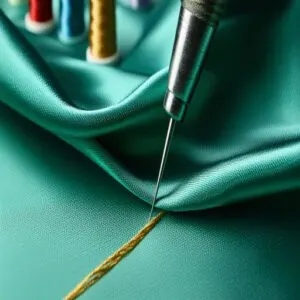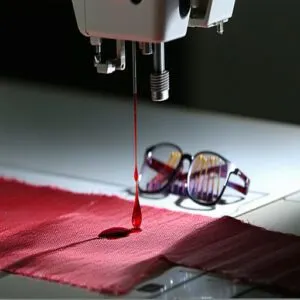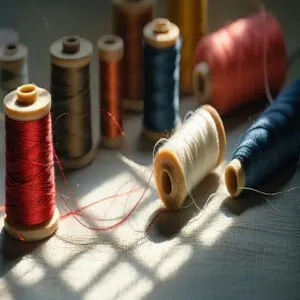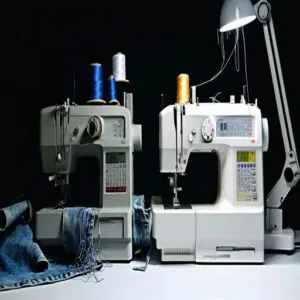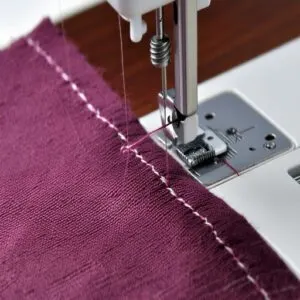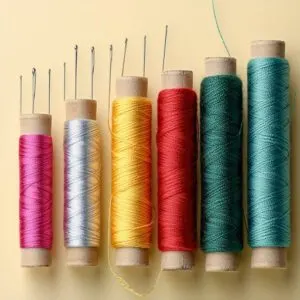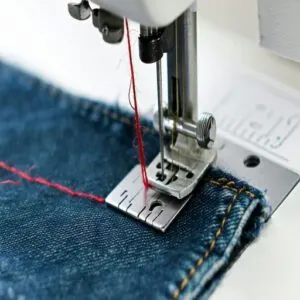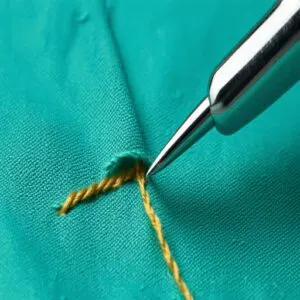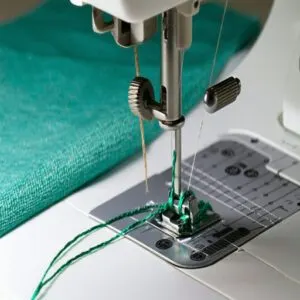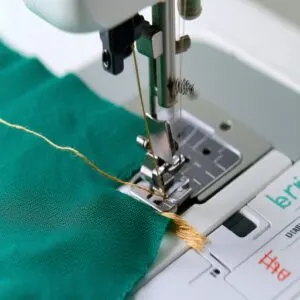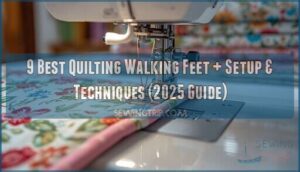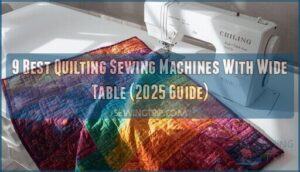This site is supported by our readers. We may earn a commission, at no cost to you, if you purchase through links.
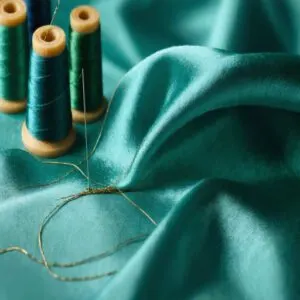
For delicate silks, pair a fine 60/8 needle with 50-60 weight thread, while medium-weight cottons need an 80/12 needle with 40-50 weight thread.
Heavyweight fabrics like denim require a sturdy 100/16 needle with 30-40 weight thread, and this balance is crucial for achieving professional results.
Think of it like Goldilocks – you want everything just right, as this will make your machine purr like a kitten when you use the right combinations, and you’ll avoid those frustrating thread breaks and skipped stitches.
There’s a whole world of specialty threads waiting to reveal your creative potential.
Table Of Contents
Key Takeaways
- You’ll achieve perfect stitches by matching your needle size to both fabric weight and thread thickness – use 60/8 needles with 50-60 weight thread for silks, 80/12 with 40-50 weight for cottons, and 100/16 with 30-40 weight for denim.
- You’ll need to ensure your top and bobbin threads are properly balanced – when using thicker top thread, opt for 60wt cotton in your bobbin to maintain optimal tension and stitch formation.
- You’ll want to check your home sewing machine’s thread weight limitations – most can only handle up to Tex 70 before risking damage, while heavy-duty machines can manage up to Tex 92 thread and size 22 needles.
- You’ll find the 80/12 needle size is most versatile – it works with medium-weight fabrics and common thread weights from 50-80wt, making it ideal for everyday sewing projects.
Needle Size Selection
You’ll need to match your needle size to both your fabric weight and thread thickness for the perfect stitch every time.
Whether you’re working with delicate silk or tough denim, picking the right needle size will help you avoid those frustrating skipped stitches and thread breaks that can turn your sewing project into a headache.
Fabric Weight Considerations
Picking the perfect needle starts with understanding fabric density.
For lightweight fabrics like silk, you’ll want finer needles (60/8-75/11), while medium-weight cottons need 80/12-90/14 needles.
Heavy materials like denim demand stronger needles (100/16-110/18).
For more detailed guidance, explore this sewing machine needle guide.
Your sewing speed and needle durability depend on matching material thickness to the right size – just think of it like matching shoes to terrain.
Thread Thickness Matching
When you match thread thickness to your needle size, you’re setting yourself up for perfect stitches.
Thread weight and needle calibration go hand in hand – think of them as dance partners that need to be in sync.
Proper thread matching and tension are essential for achieving balanced stitches, especially when using different thread types or weights.
For lightweight fabrics (low fabric density), pair size 60-70 needles with fine threads like 50-60 weight.
Medium materials need 80-90 needles with 40-50 weight threads.
Heavy fabrics demand 100-110 needles matched with 30-40 weight threads for ideal stitch visibility.
Safety Precautions
With thread and needles sorted, let’s talk about keeping your fingers intact.
Always wear those safety glasses – you’d be amazed how far needle bits can fly when they snap.
Store your needles in a dedicated case, not scattered in your sewing box. Keep machine guards in place, and never sew over pins.
Got a dull or bent needle? Chuck it – damaged needles are accidents waiting to happen.
Following proper sewing safety precautions is vital to minimize risks and guarantee a safe sewing experience.
Needle Size Charts
Working safely is step one, but knowing your numbers is what’ll make you sew like a pro.
Your sewing machine needle sizes chart uses two numbers – European (60-110) and American (8-18) .
Think of it as a GPS for fabric thickness: use 60/8 for delicate silks, 80/12 for everyday cotton, and beef it up to 100/16 for tough denim.
Keep this needle size guide handy! A detailed sewing needle size chart is invaluable for selecting the correct needle.
Thread Type Selection
You’ll find that choosing the right thread type for your sewing project is like picking the perfect partner for your needle, where each combination creates its own unique magic.
Whether you’re working with cotton for everyday projects or synthetic threads for outdoor items, you’ll need to match your thread choice to both your fabric type and needle size to achieve those picture-perfect stitches.
Cotton Thread Uses
Now that you’ve got your needle sizes sorted out, let’s talk cotton thread – your trusty companion for everyday sewing.
For cotton fabric and fabric blends, all-purpose cotton thread is your go-to choice.
It’s perfect when you’re tweaking thread tension on basic projects.
But don’t stop there – quilting thread works magic on thicker cotton layers, while cotton perlé creates eye-catching decorative stitches that’ll make your projects pop.
Synthetic Thread Options
When diving into synthetic thread options, you’ll find polyester’s exceptional UV resistance makes it perfect for outdoor projects.
Nylon threads shine in indoor upholstery work, thanks to their natural stretch.
Your sewing machine thread choice matters – synthetic fibers offer durability that cotton can’t match.
Proper thread selection and fabric compatibility are essential for successful sewing.
For everyday projects, try rayon’s properties of strength and shine, just remember to pair these with the right needle sizes.
Specialty Thread Types
When you’re ready to level up your sewing game, specialty threads can transform your projects from basic to brilliant.
Here’s what you’ll want to try:
- Metallic threads add sparkle to holiday decorations, but they need special needles to prevent shredding
- Silk floss creates luxurious embroidery details with minimal lint
- Wool embroidery thread gives textured, dimensional effects
- Rayon usage shines in decorative stitching, while nylon applications work best for synthetic fabrics
For dazzling embellishments, explore various metallic sewing thread products.
Looking for the perfect needle and thread combinations? Keep these specialty options in your toolkit for when inspiration strikes.
Thread Weight Selection
Beyond specialty threads, let’s talk Weight Selection smarts.
Your thread’s tex number shows how many grams 1,000 meters weighs.
For everyday sewing, stick to tex 25-40 for medium fabrics.
Want perfect Sewing Tension? Light fabrics love 60-80wt threads, while tough materials need heavier tex 70-90 options.
Check your Fabric Density before choosing – it’ll save you headaches later.
Sewing Machine Limitations
You’ll want to check your home sewing machine’s limitations, as most can only handle thread weights up to Tex 70 before risking damage.
If you’re working with thicker materials or heavier threads, you might need to upgrade to a heavy-duty machine that can handle up to Tex 92 thread and size 22 needles.
Home Machine Thread Weight Limits
Most home sewing machines have strict thread weight limits you’ll need to watch.
The maximum thread weight your machine can handle is Tex 70, and you’ll want to stick with a 100/16 to 110/18 needle for best performance.
Pushing your machine’s capacity with heavier threads risks damage, so keep an eye on your sewing speed and thread combinations when working with thicker materials.
Heavy-Duty Machine Options
Looking to tackle tougher projects?
A heavy-duty sewing machine might be your new best friend.
The Singer 4452 powers through thick fabrics at 1,100 stitches per minute, while the Brother CS7000X comes with 70 built-in stitches and a walking foot for quilting.
For industrial-level sewing, check out the Consew 206RB-5 – it’s perfect for camping gear and outdoor projects.
Needle Size Compatibility
While heavy-duty machines can handle thick threads, proper needle calibration is still your best friend.
You’ll need to fine-tune your needle sizes for sewing based on your fabric thickness and thread tension.
The American sizing system runs from 8 to 19, making stitch formation a breeze when you match it right.
Think of it like dancing – your needle and thread need perfect harmony for sewing precision.
Machine Upgrades
Say goodbye to your machine’s limitations with 2025’s cutting-edge industrial modifications. Today’s sewing upgrades can transform your basic machine into a powerhouse that rivals professional equipment.
For truly advanced capabilities, explore advanced sewing machines features like automatic thread cutters and knee lifters.
- Install a DC servo motor system for speeds up to 5,500 stitches per minute
- Add a top and bottom feed mechanism for better control with thick materials
- Upgrade to precision-engineered needle compatibility systems
- Consider a high-speed industrial conversion kit with advanced tension control
Thread Needle Combinations
You’ll find that matching your thread weight to your needle size is like finding the perfect dance partners – they need to work together smoothly to create beautiful stitches.
With the right combinations, such as using an 80/12 needle for 50wt thread or a 100/16 needle for 12wt thread, you’ll get perfect tension and avoid those frustrating thread breaks or skipped stitches.
Top and Bobbin Thread Pairing
Perfect stitch consistency starts with the right thread balance between top and bottom threads.
You’ll know you’ve nailed your bobbins tension when threads meet in the middle of your fabric.
For the best needle thread combinations, pair similar weight threads together – but if you’re using thicker top thread, a 60wt cotton in your bobbin helps maintain that sweet spot.
Think of it as keeping your sewing seesaw balanced.
Thread Weight and Needle Size
To nail perfect stitch formation, you’ll need the right combo of thread weight and needle size.
Here’s what works like a charm:
- 80-weight thread + size 80/12 needle for silks and delicates
- 50-weight thread + size 80/12 needle for everyday sewing
- 40-weight thread + size 90/14 needle for medium fabrics
- 30-weight thread + size 100/16 needle for denims
- 12-weight thread + size 110/18 needle for heavy upholstery
The higher the tex number, the thicker your thread – match it with bigger needles for exceptional sewing precision.
This balance is crucial for achieving professional results in various sewing projects.
Troubleshooting Thread Breaks
Even the best thread-needle combo can face sudden breaks.
When your thread starts acting up, check these common breakage causes first. Here’s your quick fix guide for those pesky thread breaks and stitch issues.
| Problem | Quick Fix |
|---|---|
| Incorrect Threading | Rethread machine from scratch |
| Thread Tension Too Tight | Adjust top and bobbin tension |
| Damaged Needle | Replace with fresh needle |
| Poor Thread Quality | Switch to premium thread |
| Lint Buildup | Clean machine thoroughly |
Let’s fix that frustrating thread shredding before your next seam!
Optimizing Stitch Quality
Now that you’ve fixed those thread breaks, let’s fine-tune your stitch quality.
Start with your sewing speed – slower is smoother when dealing with thread tension adjustments. Check your stitch tension by test-sewing on scrap fabric; if needle thread shows underneath, your bobbin’s too tight or upper tension’s too loose.
Turn the tension dial in quarter-turn increments until your stitches look balanced.
Your needle size and thread weight should always play nice together.
Thread and Needle Recommendation Charts
Now that you’ve mastered stitch quality, let’s make sense of those mysterious numbers on your needle box.
A handy sewing machine needle chart shows you’ll want 90/14 or 100/16 needles for 30-weight thread, while 40-weight thread pairs best with 80/12 or 90/14 sizes.
Keep these fabric guides near your machine – they’re like a cheat sheet for perfect sewing machine needle thread pairing.
For more detailed information, consult a thorough sewing machine needle chart.
Online Resource Guides
To build on those handy charts, you’ll want to explore BERNINA’s needle guide and Mettler’s manufacturer pages for in-depth thread pairing tips.
AllPeopleQuilt.com’s Ultimate Thread Guide is your go-to for matching threads with different projects.
For additional product options, explore this helpful sewing needle thread chart.
Need a visual guide? MadamSew’s video tutorials show you exactly how to use their Needle Threader tool.
These sewing communities and resource websites make finding the best needle-thread combo a breeze.
Frequently Asked Questions (FAQs)
What is the best thread for a sewing machine needle?
Like a perfect dance partner, you’ll want a thread weight that matches both your fabric and needle size.
For most projects, a 50-weight all-purpose polyester thread paired with an 80/12 needle works beautifully.
What are 90-14 needles used for?
Your 90/14 needles work best with medium-weight fabrics like linen, corduroy, and quilting cotton. They’ll handle 40-50 weight threads smoothly and are great for everyday sewing projects you’ll tackle at home.
What is the most versatile sewing machine needle size?
You’ll absolutely love the 80/12 size – it’s the Swiss Army knife of sewing machine needles.
You can use it confidently with most medium-weight fabrics and common thread weights from 50-80wt.
What is the difference between 75-11 and 80-12 needles?
A 75/11 needle’s slightly thinner than an 80/12, making it ideal for lightweight fabrics like silk and chiffon. You’ll want the 80/12 for medium-weight materials like cotton, linen, and light denim.
Can metallic threads damage needles over time?
You’re right to worry.
Metallic threads can wreak havoc on your needles, causing wear and dulling over time.
That’s why it’s smart to switch needles more frequently when you’re working with these sparkly troublemakers.
How often should I oil my needle assembly?
You’ll need to oil your needle assembly every 8-10 hours of sewing time.
This is a crucial maintenance step, as a quick drop keeps everything running smoothly and prevents unnecessary wear on your machine’s parts.
Which thread colors fade least in sunlight?
You might worry about color staying power, but UV-treated polyester threads resist fading best.
For outdoor projects, you’ll get the most sun-stable results with specially treated synthetic threads in any color except bright red.
Do magnetic pin cushions affect needle performance?
Your magnetic pin cushion won’t harm needle performance at all.
The magnets are too weak to affect your needle’s material or your machine’s accuracy.
Just keep the cushion a few inches from computerized machines for extra safety.
Can temperature changes impact thread tension settings?
Just like Mother Nature’s mood swings, temperature and humidity can make your thread expand or contract. You’ll need to decrease tension in hot, humid weather to maintain those perfect stitches.
Conclusion
Just like a chef pairs the right knife with ingredients, mastering the best sewing machine needle thread combinations is your key to flawless projects.
You’ve now got the knowledge to match delicate silks with fine needles and sturdy denims with heavy-duty options.
Remember, your machine’s sweet spot lies in these perfect pairings, so trust your instincts, experiment with confidence, and watch your stitching transform from good to outstanding.
Your fabric, thread, and needle are ready to work in harmony – go create something amazing!
- https://www.allpeoplequilt.com/how-to-quilt/quilting-basics/four-common-machine-needle-and-thread-combinations
- https://www.sewingmachinefun.com/sewing-machine-needle-chart/
- https://www.mhthread.com/blog/products/canvas-thread-and-needle
- https://help.brother-usa.com/app/answers/detail/a_id/152271/~/how-to-determine-the-correct-combination-of-fabric,-thread-and-needle-to-use
- https://directus.sailrite.com/assets/5427bdca-47d7-48f5-be6e-05fae1d1417e

